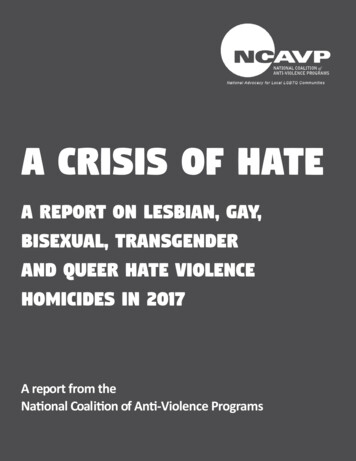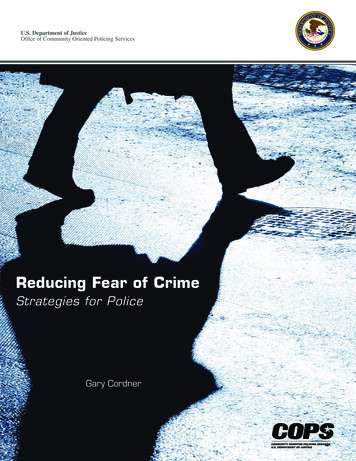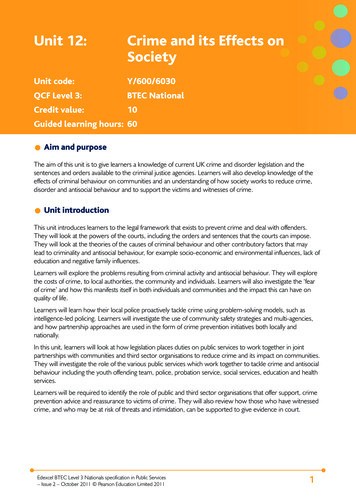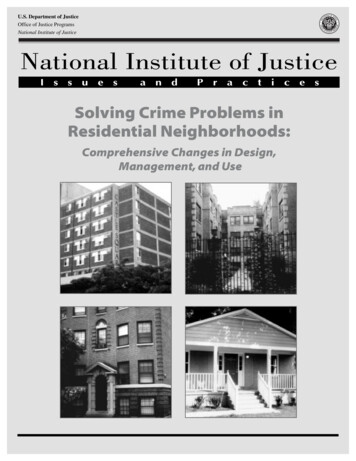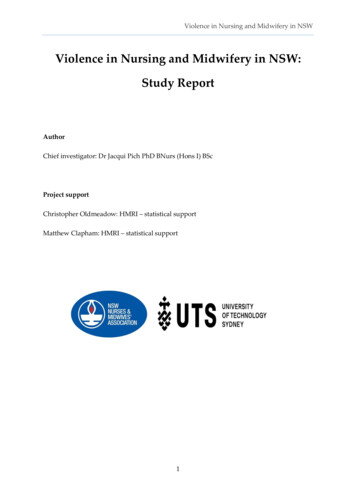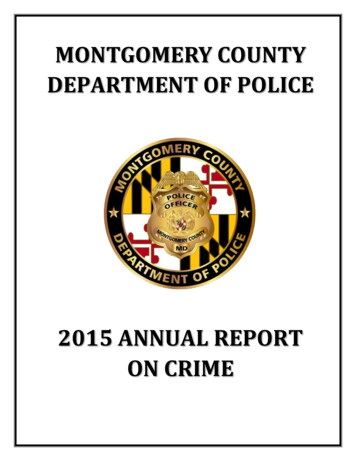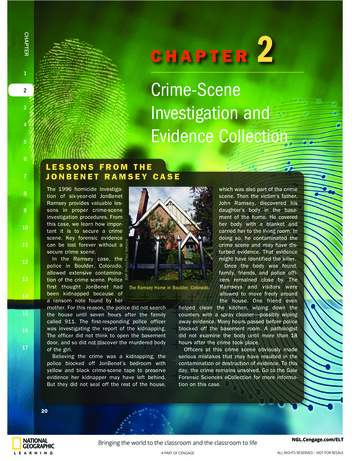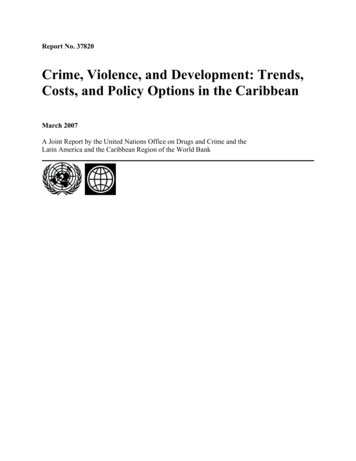
Transcription
Report No. 37820Crime, Violence, and Development: Trends,Costs, and Policy Options in the CaribbeanMarch 2007A Joint Report by the United Nations Office on Drugs and Crime and theLatin America and the Caribbean Region of the World Bank
ACRONYMS AND RNNRSSRTFCSUNODCWDRWHOAlternative Dispute ResolutionCountry Economic MemorandumCaribbean Financial Action Task ForceCOSAT Guard for the Netherlands Antilles and ArubaConsejo Nacional de la NiñezCorruption Perceptions IndexCrime Prevention Through Environmental DesignCrime Trends Surveys – United NationsDisability-Adjusted Life YearsDepartment of Homeland SecurityEducación Básica para Adultos y JóvenesEconomic Commission for Latin America and the CaribbeanEncuesta Nacional de Hogares de Propósitos MúltiplesEuropean Union/Latin American and the CaribbeanFuerzas Armadas Revolucionarias de ColombiaGross Domestic ProductInvestment Climate SurveyInternational Crime Victims SurveyLatin America and CaribbeanOrganization of Eastern Caribbean StatesProgram for Appropriate Technology in HealthRoyal Navy of the NetherlandsRegional Security SystemRegional Task Force on Crime and SecurityUnited Nations Office on Drugs and CrimeWorld Development ReportWorld Health OrganizationVice President: Pamela CoxCountry Director: Caroline AnsteyPREM Director: Ernesto MaySector Manager: Jaime Saavedra ChanduviLead Economist: Antonella BassaniTask Managers: Andrew R. MorrisonBernice Van BronkhorstGabriel DemombynesTheodore Leggett (UNODC)
TABLE OF CONTENTSPrefaceAcknowledgmentsExecutive Summary iChapter 1. Conventional Crime: an Overview 1The Diversity of the Caribbean 2How to Measure Crime? 4Homicide and Assault 7Violence Against Women 12Property Crime 13Chapter 2. Organized Crime 15Drug Trafficking 15Other Forms of Organized Crime: Kidnapping, Money Laundering, Corruption 21Chapter 3. Risk Factors for Crime and Violence 26Conceptual Foundations of Risk Factors for Crime and Violence 26Macro Analysis of Risk Factors for Crime in the World and the Caribbean 27Risk Factors for Crime at the Household Level: Evidence fromThree Caribbean Countries 34Policy Implications 40Chapter 4. Socioeconomic Costs of Crime 41Approaches to Measuring the Costs of Crime and Violence 42Specific Costs of Crime 43Total Costs: Estimates Using an Accounting Approach 50Disability-Adjusted Life Years Lost to Violence 53The Impact of Victimization on Self-Reported Life Satisfaction 56The Impact of Violent Crime on Economic Growth 57Policy Implications 59Chapter 5. Youth Violence in the Caribbean: A Case Study ofthe Dominican Republic 61Scope of Youth Crime and Violence 62Factors Contributing to Youth Violence 67Policy Recommendations for Strengthening the Response to Youth Violence 73Conclusions 79Chapter 6. Case Study: Criminal Deportations and Jamaica 81The Scale of the Expatriate Population 83Criminal Deportation 84Policy Implications 91Chapter 7. Case Study: Drug Trafficking and the Netherlands Antilles 93Drug Trafficking on Commercial Air Flights: an Innovative Policy Response 96Maritime Trafficking 101Policy Implications 102
Chapter 8. The Contributions of Criminal Justice Systems to the Control of Crime andViolence: A Case Study of Jamaica and the Dominican Republic 105Introduction: Criminal Justice Reform in Civil and Common Law System 105Country Cases: Two Approaches to Criminal Justice Reform 108A Quantitative Evaluation of System Performance: Performance Statisticsand Indicators 112Measuring the System’s Workload: Reported Offenses 113Institutional Performance Measures 114Impact Indicators: Using Crime and Arrest Data for Crime Prevention 122Conclusion: From Organizational Reform and Performance Measurement toInteragency Governance 126Chapter 9. Guns and Crime: A Case Study of Trinidad and Tobago 128Sources 130Registration of Firearms and Seizures of Illegal Weapons 131Demand 132Victims, Perpetrators and their Environment 132Drug Trafficking and Gun-Related Criminality 133Policy Implications 136Chapter 10. Public Policy of Crime and Violence Prevention: Regional andNational Approaches 141Sectoral and Cross-Sectoral Approaches 141Regional Initiatives to Address Crime and Violence 145Priority Steps to Achieve Reductions in Crime and Violence in the Caribbean 149References 141Annexes 175FIGURESFigure 1.1: Ranking of Caribbean Countries in the Human Development Index -------------------------------- 3Figure 1.2: Population Distribution of the Independent Caribbean ------------------------------------------------ 3Figure 1.3: Murder Rates by --------------------------------------- 4Figure 1.4: Murders per 100,000 Population by Year, Anguilla - 6Figure 1.5: Number of Murders in Guyana, Police and Public Health Sources ---------------------------------- 7Figure 1.6: Deaths Rates from Violence in Caribbean and Comparison Countries ----------------------------- 9Figure 1.7: Homicides per 100,000 in Guyana and ------------10Figure 1.8: Homicides Rates in the Dominican Republic, St. Lucia and Trinidad and Tobago: 1999-2005 11Figure 1.9: Assault Rates in Caribbean and Comparison Countries gure 1.10: Rape Rates in Caribbean and Comparison Countries igure 2.1: Cannabis Eradication in Jamaica ----------------------17Figure 2.2: Shares of Cocaine Flowing to the United States by Transport Corridors --------------------------17Figure 2.3: Origin of Heroin Seized in the United States --------19Figure 2.4: Kidnappings per 100,000 Population in Trinidad and Tobago --------------------------------------23Figure 3.1: Ecological Model for Understanding Crime and Violence ------------------------------------------27Figure 3.2: Cross-Country Correlates of Crime -------------------29Figure 3.3: Robbery Rates vs. Mean Consumption by Neighborhood e 3.4: Distribution of Victimization by Crime and Quintile in Haiti ---------------------------------------37
Figure 4.1: Responses to Fear of Crime in Dominican Republic -What Do People Stop DoingDue to Fear? gure 4.2: Responses to Fear of Crime in Haiti: Where Do People Stop Going Due to Fear? ---------------45Figure 4.3: Impact of Crime on Various Business Practices in Jamaica -----------------------------------------47Figure 4.4: Crime Protection Measures Taken by Firms in Jamaica ure 4.5: Private Security Costs for Firms by Size of Enterprise as Percentage of Firm Revenuein ------49Figure 4.6: Crime Protection Measures Taken by Firms in the Dominican Republic --------------------------49Figure 4.7: Impact of Higher Crime on Businesses in the Dominican Republic --------------------------------50Figure 4.8: How Reliable is WHO Homicide Information for the Caribbean? Homicide RatesAccording to WHO vs. Official Sources Homicide Deaths per 100,000 Population -------------54Figure 4.9: Disability-Adjusted Life Years Lost to Violence in the Caribbean, 2002--------------------------55Figure 4.10: Disability-Adjusted Life Years Lost to Violence vs. Other Causes Caribbean 2002 -----------55Figure 4.11 Potential Boost to Annual Economic Growth Rate from Reducing Homicide Rate toCosta Rica Level -----------------------------------------59Figure 5.1: Homicide Deaths by Age (10-29) in the Dominican Republic (2000-2005)-----------------------65Figure 5.2: Trends of Minor Arrest over Past Decade in the Dominican Republic-----------------------------66Figure 6.1: Number of Deportees and Number of Murders in Jamaica ------------------------------------------82Figure 6.2: Caribbean-Born Populations in the United States ---84Figure 6.3: Total Criminal Deportations from the U.S. to the Caribbean ----------------------------------------85Figure 6.4: Criminal Deportees from the U.S. per 100,000 Population of Home Country --------------------86Figure 6.5: Total Criminal Deportations to Jamaica: 1998-2004 6Figure 6.6: Drug Deportations to Jamaica from the United States and the United Kingdom -----------------87Figure 6.7: Breakdown of Criminal Deportees by Crime Type, All Three Source Countries, 2001-2004 --88Figure 6.8: Age on Arrival in the U.S. of Jamaican Criminal Deportees (Percent of Headley’s Sample) - 889Figure 6.9: Age on Deportation from the U.S. of Jamaican Criminal Deportees (Percent of Headley’sSample) -90Figure 7.1: Kilograms of Cocaine Seized in Caribbean Territories in 2004 -------------------------------------95Figure 7.2: Kilos of Cocaine Seized in the Netherlands Antilles, 1980-2004 -----------------------------------96Figure 7.3: Couriers Detected arriving at Schiphol from Curacao, by quarter ----------------------------------99Figure 7.4: Cocaine Seizures in Trinidad and Tobago --------- 103Figure 8.1: Sentenced and Unsentenced Prison Inmates, Dominican Republic, May 2003 to May 2006 - 119Figure 8.2: Prison Deaths, Escapes, and Recaptures, Dominican Republic ----------------------------------- 120Figure 8.3: Unnatural Deaths and Violent Incidents in Jamaican Prisons, 2000-2005 ----------------------- 121Figure 9.1: Distribution of Injury Deaths by Type of Injury: Trinidad and Tobago, 1999-2003 ----------- 129Figure 9.2: Police Reports of Narcotics Possession and Murders, and Certified Firearm Homicides:Trinidad and Tobago, ----------------------------- 133BOXESBox 1.1 Crime Definitions -------------------------------------------- 5Box 2.1: Financial Fraud in the Dominican Republic – The Baninter Case -------------------------------------25Box 3.1: Haiti’s Entrepreneurs of Violence -----------------------38Box 5.1: The Sophisticated Extortion of Santo Domingo Gangs and Drug Lords------------------------------67Box 8.1: Using Crime Data and Analysis to Formulate a Multi-Sectoral Crime Prevention Strategy:The Barrio Seguro Program in Capotillo ----------- 124Box 9.1: Young Men, Drugs, and Guns -------------------------- 136Box 9.2: UN Resolution and Plan of Action on Small Arms and Light Weapons ---------------------------- 139Box 9.3: Gun Buybacks -------------------------------------------- 140Box 10.1. Crime and Violence Prevention Components in Bank-Financed Integrated Slum UpgradingOperations – Jamaica Inner Cities Basic Services for the Poor Project--------------------------- 146Box 10.2. The Pride in Gonzales Initiative, Port of Spain, Trinidad and Tobago: A Community-DrivenSocial Development ------------------------------- 147Box 10.3. The Need for Better Data on Crime ------------------ 151
TABLESTable 2.1: Highest Total Annual Cocaine Seizure, -----------21Table 3.1: Cross-Country Analysis - Basic Regression --------32Table 3.2: Summary of Micro-Analysis of Risk Factors for Criminal Victimization --------------------------35Table 4.1: Effects of Lifetime Physical Violence by Intimate Partner in Haiti ---------------------------------46Table 4.2: The Costs of Crime in Jamaica: an Accounting Exercise le 4.3: Cross-Country Regression Estimate of the Effect of Violent Crime on Economic Growth ------58Table 5.1 Youth as Victims: Homicide Rates in Select Countries Table 5.2: Highlights of Youth in Numbers in Latin America and the Caribbean------------------------------69Table 5.3: Violence Prevention Strategies by Developmental Stage and Ecological Context ----------------76Table 8.1: Homicide Clearance Rates in Jamaica by “Murder Motive,” 2005 and 2006 -------------------- 115Table 9.1: Murders Committed in Trinidad and Tobago Using a Firearm, 2001-2006 ---------------------- 129Table 9.2: Woundings Committed in Trinidad and Tobago Utilizing a Firearm, 2000-2005 --------------- 130Table 9.3: Firearm Seizures in Trinidad and ----------------- 132Table 9.4: Modified Haddon Matrix Applied to the Analysis of Gun-Related Criminality (GRC) -------- 135Table 9.5. Possible Interventions Specific to Guns and ----- 138Table 10.1. Public Policy Approaches and Interventions to Address Urban Violence ----------------------- 144ANNEXESAnnex 1.1. Caribbean Leaders on ------------------------------ 175Annex 1.2. Tourism and the Caribbean Economy -------------- 175Annex 1.3. Emigration and Crime -------------------------------- 175Annex 1.4. Caribbean Police Forces and Prison ------------- 176Annex 2.1. The Jamaica Cannabis Trade ------------------------ 177Annex 2.2. Patterns of Drug Transshipment by Organized Criminal Groups --------------------------------- 177Annex 2.3. Dates of large Seizures of Cocaine Entering Canada from Caribbean Countries 2004 -------- 178Annex 2.4. Organized Crime in Jamaica and the Dominican Republic ---------------------------------------- 178Annex 2.5. Jamaat-al-Muslimeen in Trinidad and Tobago ---- 179Annex 3.1. Caribbean Homicide Data ------------------------- 179Annex 4.1. Impact of Crime Victimization on Satisfaction with Life------------------------------------------ 184Annex 5.1. Risk Factors and Policy Responses to Youth Violence in the Dominican Republic------------ 185Annex 5.2. Inventory of Governmental Initiatives for Youth Violence Prevention in theDominican Republic ---------------------------------- 188Annex 5.3. Inventory of Civil Society Initiatives for Youth Violence Prevention in theDominican Republic ---------------------------------- 193Annex 6.1. Criminal Deportations to Jamaica by Year, Offence, and Sending Country--------------------- 199
PREFACEThis report is the result of a fruitful collaboration between the United Nations Office onDrugs and Crime (UNODC) and the World Bank. It addresses the issue of crime andviolence in the Caribbean, a complex problem that prejudices both the social andeconomic development of the region.The Governments of the Caribbean countries recognize the seriousness of the problemand are exploring innovative policy responses at both the national and regional levels.Civil society organizations are doing their part as well by designing and implementingviolence prevention programs targeting youth violence, violence against women, andother important forms of violence.Much, however, remains to be done. Some of the factors that make the Caribbean mostvulnerable to crime and violence—the drug trade and trafficking of weapons are twoimportant examples—require a response that transcends national and even regionalboundaries. Also, promising initiatives at the national level must be evaluated foreffectiveness so that scarce resources can be efficiently invested.This report is offered as a contribution to the ongoing dialogue in the region onapproaches to address crime and violence. It is not intended to provide a definitiveblueprint for action, but rather is offered as a tool to engage stakeholders—governments,civil society organizations, citizens, and international partners—in a serious dialogue oncrime and violence, based on evidence and good practices from inside and outside theregion.
ACKNOWLEDGMENTSThis report is a joint product of the United National Office of Drugs and Crime(UNODC) and the World Bank. The multisectoral team was led by Theodore Leggett(UNODC), Bernice van Bronkhorst (LCSFU), Gabriel Demombynes (LCSPP), andAndrew Morrison (PRMGE). Individual chapters were prepared by Mr. Leggett(overview chapters, criminal deportees in Jamaica, narcotics trafficking in theNetherlands Antilles), Mr. Demombynes (risk factors and costs), Linda McGinnis andPeter Holland (HDNCY: youth in the Dominican Republic), and Ms. van Bronkhorst andMr. Morrison (public policy). The criminal justice chapter was written by LinnHammergren (LCSPS) and Stephanie Ann Kuttner (SDV), based on a background paperon criminal justice prepared by Todd Foglesong (Vera Institute of Justice) andChristopher Stone (Harvard University). The firearms chapter was written by Bernice vanBronkhorst, Andrew Morrison, and Theodore Leggett, based on a background paperprepared by Yvette Holder (independent consultant) and Folade Mutota (Women’sInstitute for Alternative Development, Trinidad and Tobago). The team benefited fromsignificant contributions from Ana Maria Diaz (LCSPP) and Mariel Fiat (LCCDO), aswell as the excellent assistance of Ane Perez Orsi de Castro (LCSPP) in the preparationof the final report. The team would also like to thank the following individuals for theircontributions: Lisa Bhansali, Teresa Genta-Fons, Lillian Mallet Crawford Abbensetts,Willy Egset, Dorte Verner, and Christina Malmberg Calvo.The team is very grateful for the work and insightful comments of its External AdvisoryCommittee, chaired by Professor Anthony Harriott (Professor, University of the WestIndies-Mona, Jamaica) and comprised of Dr. Franklin Almeyda (Minister of the Interiorand Police, Dominican Republic), Mr. George de Peana (General Secretary, CaribbeanCongress of Labor, Barbados), Professor Ramesh Deosaran (Director, Center forCriminology and Criminal Justice, University of the West Indies-St. Augustine, Trinidadand Tobago), Dr. Len Ishmael (Director General, OECS Secretariat, St. Lucia), ColonelTrevor MacMillan (Chairman, Standing Committee on National Security of the PrivateSector Organization of Jamaica), the Honorable Dale D. Marshall (Attorney General,Barbados), and the Honorable Gail Teixeira (Special Advisor to the President andDirector, Governance Unit, Office of the Presidency, Guyana).This task was guided and supervised by Jaime Saavedra (Sector Manager, LCSPR) andAntonella Bassani (Lead Economist, LCSPR). The peer reviewers were Pablo Fajnzylber(LCSFR), Wendy Cunningham (LCSHS), and Anthony Harriott (University of the WestIndies, Mona Campus).
EXECUTIVE SUMMARYIn his 2006 New Year’s address as then prime minister of Jamaica, P.J. Patterson said,“Without a doubt, the high level of violent crime remains our most troubling and pressingproblem.” In opening the Parliament of Trinidad and Tobago in September 2005,President George Maxwell Richards said the country was in crisis due to the escalatingcrime rate. Through multiple channels, crime and violence threaten the welfare ofCaribbean citizens. Beyond the direct effect on victims, crime and violence inflictwidespread costs, generating a climate of fear for all citizens and diminishing economicgrowth. Crime and violence present one of the paramount challenges to development inthe Caribbean.Several factors which cut across the diverse countries of the region heighten theirvulnerability to crime and violence. Primary among these is the region’s vulnerability todrug trafficking. Wedged between the world’s source of cocaine to the south and itsprimary consumer markets to the north, the Caribbean is the transit point for a torrent ofnarcotics, with a street value that exceeds the value of the entire legal economy.Compounding their difficulties, Caribbean countries have large coastlines and territorialwaters and many have weak criminal justice systems that are easily overwhelmed.Key messages and recommendations from the report include the following:1) Crime and violence are a development issue. The high rates of crime andviolence in the region have both direct effects on human welfare in the short-runand longer run effects on economic growth and social development. Estimatessuggest that were Jamaica and Haiti to reduce their rates of homicide to the levelof Costa Rica, each country would see an increase in its growth rate of 5.4 percentannually.2) While levels of crime and associated circumstances vary by country, the strongestexplanation for the relatively high rates of crime and violence rates in theregion—and their apparent rise in recent years—is narcotics trafficking. Thedrug trade drives crime in a number of ways: through violence tied to trafficking,by normalizing illegal behavior, by diverting criminal justice resources from otheractivities, by provoking property crime related to addiction, by contributing to thewidespread availability of firearms, and by undermining and corrupting societalinstitutions. At the same time, it should be recognized that there is a trade-offbetween resources spent on combating drug trafficking and those spent on otherforms of crime and violence prevention.3) In general, there has been an over-reliance on the criminal justice approach tocrime reduction in the region, to the detriment of other complementaryapproaches which can be effective in reducing certain types of crime andviolence. Over the last few years, however, several countries such as Jamaica andthe Dominican Republic are increasingly investing in different approaches. Crimeprevention through environmental design (CPTED), the study and design ofenvironments to encourage desirable behavior and discourage antisocial behavior,has significant potential to generate rapid decreases in property crime and somei
forms of inter-personal violence. Integrated citizen security approaches haveseen initial success in the Dominican Republic and should be explored elsewhere.These programs, by combining modern methods of policing with preventioninterventions undertaken by both government and non-governmentalorganizations, are extremely promising. The public health approach, whichfocuses on modifying risk factors for violent conduct, is especially promising foraddressing violence against women and youth violence.4) At the same time, it is also crucial to note that certain types of crime andviolence—in particular, organized crime and drug trafficking—are largelyimpervious to prevention approaches; a criminal justice-focused approach isessential in dealing with them. Within the criminal justice approach, there ismuch room for improvement. An especially urgent priority is the developmentof management information systems and performance indicators for betterproblem diagnosis, tracking of system outputs, monitoring reform programs andproviding increased accountability to citizens.5) These different approaches mean that there are multiple possible entry points toengage in violence and crime prevention. In one instance, the most promisingapproach may be in the context of a slum-upgrading project; in another, in thecontext of a reform of the health service; in a third, in the context of a reform ofthe criminal justice system. There is no one “ideal” approach. The commondenominator is that successful interventions are evidence-based, starting with aclear diagnostic about types of violence and risk factors, and ending with a carefulevaluation of the intervention’s impact which will inform future actions.6) Evidence from Jamaica and other countries shows that the average deportee is notinvolved in criminal activity, but a minority may be causing serious problems,both by direct involvement in crime and by providing a perverse role model foryouth. More services should be offered to reintegrate deportees, along the linesof those provided by the Office for the Resettlement of Deportees in St. Kitts andNevis. Options should be explored for deporting countries to shoulder asignificant portion of the costs of these programs, in exchange for seriousmonitoring and evaluation of program impacts.7) Given that Caribbean countries are transit and not producer countries of cocaine,interdiction needs to be complemented by other strategies outside the region(principally demand reduction in consumer countries and eradication and/oralternative development in producer countries). Within the region, policies shouldfocus on limiting the availability of firearms and on providing meaningfulalternatives to youth. Since the Caribbean nations have limited resources toeffectively fight the drug trade, significant assistance should come from thedestination countries in support of interdiction efforts. The case study of theNetherlands Antilles shows this to be both effective and in the self-interest ofdeveloped countries.8) Gun ownership is an outgrowth of the drug trade and, in some countries, ofpolitics and associated garrison communities. Within these environments, whichii
promote the demand for weapons, reducing gun ownership is a difficultundertaking. Better gun registries, marking and tracking can help, as canimproved gun interdiction in ports. Long run and sustained reduction in thedemand for guns, however, will hinge on progress in combating drugs.9) To address issues of youth violence, policy makers in the short run shouldborrow from the toolkit of evidence-based programs from other regions, suchas early childhood development and mentoring programs, interventions toincrease retention of high-risk youth in secondary schools, and opening schoolsafter-hours and on weekends to offer youth attractive activities to occupy theirfree time. While there are a multitude of programs in the region that address youthviolence, few if any have been subject to rigorous impact evaluation. In themedium and long run, impact evaluations should systematically document whatworks in youth violence prevention in the Caribbean.10) This report has culled many different sources of data to present as comprehensivea picture as possible of crime and violence in the Caribbean. Yet it is clear thatthere are major data gaps that hinder policy making. Chief among them is thelack of regular, periodic victimization surveys that permit comparison of crimelevels both across countries and over time.ROAD MAP OF THE REPORTThe report is organized as follows. It begins with an overview of crime in the region,separately considering conventional and organized crime. Two subsequent chaptersexamine risk factors and the costs of crime for the region as a whole. Next, a series ofchapters presents case studies designed to highlight particular issues in specific countries.These case studies were chosen in order to provide a detailed analysis
The Jamaica Cannabis Trade ----- 177 Annex 2.2. Patterns of Drug Transshipment by Organized Criminal Groups----- 177 Annex 2.3. Dates of large Seizures of Cocaine Entering Canada from Caribbean Countries 2004 ----- 178 Annex 2.4. Organized Crime in Jamaica and the Dominican Republic----- 178 .
